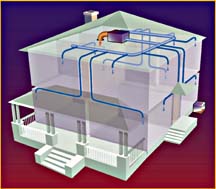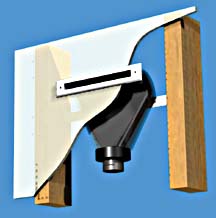
Unico is battling to increase consumer awareness toward its products. Not enough people understand the product, according to Unico marketing coordinator Tom Taylor.
Taylor would like to see new markets for his company’s products — high-velocity forced-air HVAC systems — yet he sees one major stumbling block along the way: apathy.
“In the past, our biggest challenge was lack of knowledge about our product, both from consumers and contractors,” said Taylor. “At one time, the perception of the Unico System was as a retrofit-only product, but the same benefits that make it a natural for historic homes apply to the custom home market as well.”
There has been an explosion in the new custom home building market, and it has helped Unico’s business, according to Taylor.
While new housing starts have coughed and sputtered in 2002, custom home building remains strong. “We have a buffer against a poor economy because we are in the high-end, quality-product market,” Taylor says. “Patriotic fervor has helped us, too. People have been encouraged to go about their business and continue to make purchases.
“However, I think it will be a while before things come all of the way back. We can’t tell what kind of year 2003 will be yet, but we’re hopeful this trend will continue.”

HISTORY OF THE PRODUCT
The company was founded in 1985 by a group of independent Unique Indoor Air Comfort HVAC contractors, all of whom had experience selling and installing high-velocity, mini-duct systems.Today Unico employs 75 people. In its company literature, the product is described as “an indoor air-handling and flexible mini-duct system for use in existing buildings without ductwork or inadequate ductwork, as well as for use in new construction.”
The system works on the principle of “aspiration.” Hot and cold streams of high-velocity air enter a room, creating circulation without drafts and providing even temperatures from floor to ceiling. In cooling mode, the system removes a significant amount of moisture, which tends to make higher temperature settings more comfortable, efficient, and economical.
The system’s flexible mini-ducts can wind through existing construction, therefore requiring little or no remodeling. Outlets are small and blend into the room’s design. The Unico System’s air supply duct also has sound-absorbing tubing, the company points out, which is designed to ensure quiet airflow from each outlet.

RADIANT HEAT
Taylor said the radiant heat industry has been a big ally to his company, starting with some timely exposure on the popular TV series “This Old House” and “Hometime.”“The Unico System is a perfect complement to a radiant heat system,” he said. “It can provide cooling and as a backup to radiant heat, it can provide instant heat.”
He said that the installation process is similar to the process used to install radiant heat systems. “We have plumbers who installed radiant heat and then, once they’ve received the proper training in mini-duct systems, have gone in and installed a Unico System,” Taylor said.
For the past four years, Unico has also marketed its product in “typical” radiant heat regions of North America, namely the West and Northwestern United States and Canada. It isn’t just retrofits that are happening now.
“Five years ago, 90% of our work was in older, existing homes,” Taylor said. “Now the percentage has dropped to 60% older homes and 40% new construction.”
Although a typical Unico installation is in a single-family home, there are light commercial applications. “We do about 10% to 15% light commercial, e.g. churches, apartments, spot cooling for assembly lines, cleanroom cooling, etc.”
“Our customer base is made up of contractors who have savvy marketing skills and who have their own website,” he said. “We also have 20 independent sales rep firms that we feel are the best in the business.”
For more information, contact Unico at 800-527-0896; www.unicosystem.com (website).

Sidebar: System A Natural For Custom Homes
In August of 1997, Dr. Peter Marcus contacted Unico Inc. to request that the Unico System be installed in his new winter residence to be built in Mesa, AZ. Dr. Marcus, a resident of Westchester, NY, had installed the Unico System in his home there some 10 years prior.The 2,800-square-foot, flat-roofed, Santa Fe-style residence features a stucco finished exterior and an interior highlighted with rough-hewn timber, for a classic, rugged look.
Conventional HVAC systems would by necessity detract from the beauty of this structure due to the need to construct soffits and other routing areas for ductwork, but the flexible Unico System tubing was able to weave through existing design-included ‘dead’ spaces.
Unico tapped Bryce and Sherry Johnson of Air Conditioning By Jay for the job. Air Conditioning By Jay is a nationally recognized HVAC contractor that specializes in custom installations, but this was their first experience with the Unico System. Steve Intagliata of Unico, who has installed more than 1,000 of these systems, assisted the Johnsons and their crew.
Because of the overall size of the home and its use of large, open areas, Intagliata and the Johnsons agreed that it would be best to install two separate Unico systems to ensure complete indoor comfort. A 2.5-ton system was installed to handle the private living area, which consisted of the main bedroom, main bath, office, and exercise room. A 4-ton system was used for the common living area which includes the entryway, two guest bedrooms, a guest bath, kitchen, and great room.
Both Unico air handlers and heat pump coils were installed in two mechanical areas specifically designed for the home. The 7-inch-round main trunk lines were installed in the dead space between the ceiling and the roof; 11 outlets supply air to the private living area and 18 supply to the common living area.
The Marcus family knew from their experience with their Westchester home that the Unico system is suited for heating as well as cooling. Two Lennox Model 12HPB-30 and Model 12HPB-48 heat pump/condensers (supplied by Dave Dobbins of Lennox Industries, Phoenix, AZ) are being used in conjunction with the Unico air handlers and coils.
Dr. Marcus has worked hard to make this home a true showplace that will include stables, desert landscaping, a swimming pool with a waterfall and sand beach, and an eight-person hot tub on the roof. It is part of a high-end, custom-built development located near the award-winning golf courses in the Red Mountain area of Mesa.
Sidebar: Constant Comfort For Custom Home
In the desert communities of central California, the days can be extremely hot and the nights noticeably cool.In an upscale neighborhood in Bakersfield, new construction for a custom-built home was underway. To compensate for the extreme temperatures, the heating and cooling system would need to be state of the art, offer efficiency, and not detract from the appeal of the luxury home.
Prior to installing a heating and cooling system, Star Temp HVACR performed a complete heat load/loss calculation and duct design. Based on the results, the contractor recommended that the new system be designed with two zones to increase efficiency. One zone for the kitchen and living room areas would operate during the day, the other zone for the bedrooms would run at night.
Posing a challenge in the design of the system, the bedrooms in the single-story, 5,400-square-foot structure were not grouped together. Because of the “U” shape of the bedrooms’ locations, the system would require very long duct runs.
In addition to efficiency and comfort, a main concern for the homeowners was maintaining the aesthetic appeal of the French architecture. Registers used with conventional systems were considered unsightly.
Gabriel Cioffi, owner of Star Temp, had never used the Unico system. However, he knew that the challenges of this particular job could not be met by a conventional system. The Unico system’s flexible mini-ducts made the long runs to the bedroom locations easy to install and provided adequate airflow to serve the remote locations.
Fifty 5-inch-diameter round outlets were installed in the home’s ceilings, providing a superior solution to maintaining the French architecture of the interiors while providing excellent comfort for this custom home installation.
Publication date: 10/14/2002



